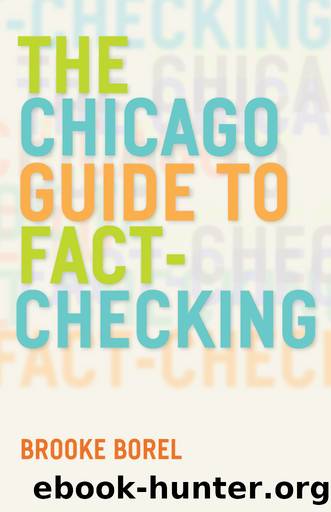The Chicago Guide to Fact-Checking by Brooke Borel

Author:Brooke Borel [Borel, Brooke]
Language: eng
Format: epub
ISBN: 9780226291093
Publisher: The University of Chicago Press
Published: 2016-08-30T00:00:00+00:00
Plagiarism and Fabrication
Plagiarism can be hard to catch on your own, but as you read a piece, along with its source materials, keep an eye out for language that seems out of place. If a section of a story sounds oddly familiar even the first time youâve read it, stop and ask yourself if you remember it from your background reading. Also keep an eye out for bits of writing that sound different from the voice in the rest of the pieceâa clue that it may have been lifted.
An even easier route, in these Internet days, is to copy and paste the story into an online plagiarism checker. There are many paid versions, such as turnitin.com, and free ones by sites such as grammarly.com. Generally, the websites flag sections that look suspect and note the sources from which they may be plagiarized. (Beware false positives: confirm that each flagged section truly is plagiarism before alerting your editor.)
Fabrication, too, can be hard to spot depending on how well writers who are dedicated to such lies cover their tracks. In the mid- to late 1990s, when Stephen Glass made up material, to varying degrees, for pretty much all of the articles he had written for the New Republic, he was able to trick the fact-checkers because he knew how they operated: he once headed the magazineâs fact-checking department. And so, especially since the Internet wasnât yet a robust research tool, he was able to make up sources and events, as well as the backup materials that supported them. Glass completely fabricated people, conversations, voice-mail messages, business cards, and more. The fact-checkers for those stories didnât have much of a chance because he was purposely trying to dupe them.2
Then there is the case of Mike Daisey, a monologist and writer. One of his popular theatrical monologues describes a trip he took to China, where he observed horrible conditions in factories that produce iPhones and other electronics. In 2012 Daisey performed the piece on the radio show This American Life. Later, after the piece aired, it became clear that Daisey made up some of the experiences described in the storyâhe exaggerated the number of factories he visited, the ages of the workers, and may have made up some of his encounters entirely. Daisey was found out in part when This American Life later interviewed his translator, who noted differences between her account and his. The radio show retracted the entire episode and dedicated another one to how the truth came out. In the prologue, Ira Glass (no relation to Stephen Glass), the showâs host, says: âThe most powerful and memorable parts of the story all seem to have been fabricated.â
Later in the episodeâwhich is filled with a lot of awkward silencesâGlass confronts Daisey directly. When he lists specific inaccuracies from the original piece, Daisey responds: âI stand by it as a theatrical work. I stand by how it makes people see and care about the situation thatâs happening there. I stand by it in the theater and I regret, deeply, that it was put into this context on your show.
Download
This site does not store any files on its server. We only index and link to content provided by other sites. Please contact the content providers to delete copyright contents if any and email us, we'll remove relevant links or contents immediately.
The Hot Zone by Richard Preston(1983)
Rigor Mortis by Richard Harris(1681)
How Innovation Works by Matt Ridley(1596)
Oxymoronica by Dr. Mardy Grothe(1513)
Mawson's Will by Lennard Bickel(1417)
Kathryn Bowers & Barbara Natterson-Horowitz by Zoobiquity(1385)
The Future of the Mind: The Scientific Quest to Understand, Enhance, and Empower the Mind by Michio Kaku(1316)
THE DEMON HAUNTED WORLD by Carl Sagan(1296)
Bankrupting Physics by Alexander Unzicker(1292)
The End of Breast Cancer by Kathleen T. Ruddy MD(1277)
Statistics Done Wrong: The Woefully Complete Guide by Alex Reinhart(1268)
The Ghost Hunters by Deborah Blum(1260)
One Two Three ... Infinity: Facts and Speculations of Science by George Gamow(1219)
The Universe Speaks in Numbers by Graham Farmelo(1198)
Science Book by Big Ideas Simply Explained(1177)
The Wizards of Langley by Jeffrey T Richelson(1097)
Biomimicry by Janine M. Benyus(1080)
Rigor Mortis: How Sloppy Science Creates Worthless Cures, Crushes Hope, and Wastes Billions by Richard Harris(1055)
The Case Against Fragrance by Kate Grenville(1029)
